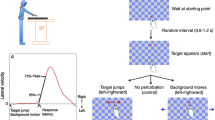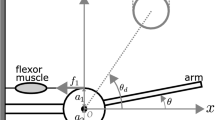Abstract
Trajectory formation of unrestrained forelimb target-reaching was investigated in relation to the effect of a change in target location. Sagittal displacement of the target (6 cm in each direction) gave a selective change of velocity in the x direction (protraction) with an increase or decrease at larger and shorter distances, respectively. In the case of a double-peaked x velocity profile, the change was mainly with respect to the first major component. The shape of the y (sideways) and of the z (lifting) velocity profiles were both almost unchanged, but the onset of the movement in the z direction changed with the x distance. Vertical displacement (4 cm up or 5 cm down) gave increased velocity in the z direction (lifting) when the target was above the normal mid-position and decreased velocity when the target was lower. The velocity was changed with constant rate of rise, so that the rise time increased when the target was elevated and shortened when the target was lowered (pulse width control policy). The change in the z velocity was not selective. In cats with a double-peaked x velocity profile, the second component decreased when the target was elevated and increased when it was lowered. With excessive lowering of the target (14 cm down), the first x velocity component was very much reduced in amplitude so that protraction depended mainly on the second x velocity component. In the cat with a unimodal x velocity profile, a second component appeared in the x and net velocity profiles when the target was excessively lowered. The velocity profile in the y direction changed when the target was lowered so that the horizontal movement path became straighter. Sideways displacement (10–13 cm) produced adduction/abduction, with only moderate changes in x and z velocity profiles. The results are discussed with reference to the angular movements in the elbow and shoulder.
Similar content being viewed by others
References
Alstermark B, Sasaki S (1983) Electromyographic activity in fast and slow elbow extensors during a visually guided forelimb movement in cats. Brain Res 259:155–158
Alstermark B, Lundberg A, Norrsell U, Sybirska E (1981) Integration in descending motor pathways controlling the forelimb in the cat. 9. Differential behavioural defects after spinal cord lesions interrupting defined pathways. Exp Brain Res 42:299–318
Alstermark B, Lundberg A, Pettersson L-G, Tantisira B, Walkowska M (1993) Characteristics of target-reaching in cats. I. Individual differences and intra-individual constancy. Exp Brain Res. 94:279–286
Armand J, Kably B, Jacomy H (1991) Lesion-induced plasticity of the pyramidal tract during development in the cat. In: Requin J, Stelmach GE (eds) Tutorials in motor neuroscience. Klüwer, Dordrecht, pp 625–640
Bernstein NA (1967) The co-ordination and regulation of movements. Pergamon Press, New York
English AW (1978) Functional analysis of the shoulder girdle of cats during locomotion. J Morphol 156:279–292
Freund H-J, Büdingen HJ (1978) The relationship between speed and amplitude of the fastest voluntary contractions of human arm muscles. Exp Brain Res 31:1–12
Gordon J, Ghez C (1987) Trajectory control in targeted force impulses. II. Pulse height control. Exp Brain Res 67:241–252
Morasso P (1981) Spatial control of arm movements. Exp Brain Res 42:223–227
Pettersson L-G (1990) Forelimb movements in the cat: kinetic features and neuronal control. Acta Physiol Scand 140 [Suppl 594]
Robinson DA (1964) The mechanics of human saccadic eye movements. J Physiol (Lond) 174:245–264
Van Opstal AS, Van Grisbergen JAM, Eggermont JJ, (1985) Reconstruction of neural control signals for saccades based on an inverse method. Vision Res 25:789–801
Author information
Authors and Affiliations
Rights and permissions
About this article
Cite this article
Alstermark, B., Isa, T., Lundberg, A. et al. Characteristics of target-reaching in cats. Exp Brain Res 94, 287–294 (1993). https://doi.org/10.1007/BF00230298
Received:
Accepted:
Issue Date:
DOI: https://doi.org/10.1007/BF00230298




